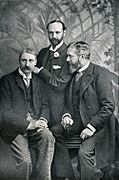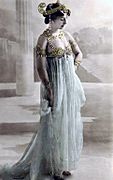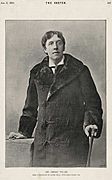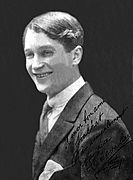Stanisław Julian Ignacy Ostroróg facts for kids
Quick facts for kids
Stanisław Julian Ignacy Ostroróg
|
|
|---|---|

Stanisław Ostroróg, the younger, circa 1890
|
|
| Born | 12 September 1863 London, England
|
| Died | 24 February 1929 (aged 65) Paris, France
|
| Nationality | Polish, British |
| Other names | Walery, Lucien Waléry, Laryew, Lucien, Stanislas Valery |
| Occupation | Photographer |
| Years active | 1890–1929 |
| Era | Belle Époque and 1920s |
| Known for | Pioneer in photography |
| Spouse(s) | Audrey Fowke |
| Parent(s) | Count Stanisław Julian Ostroróg and Teodozja Waleria Gwozdecka |
| Relatives | Leon Walerian Ostroróg, Stanislas Ostroróg, Gustaw Gwozdecki |
Stanisław Julian Ignacy Ostroróg (born 12 September 1863 – died 24 February 1929) was a famous Polish photographer. He was also known by names like Walery, Stanislas Waléry, and Lucien Waléry. He worked in London and Paris from 1890 until 1929.
Contents
Early Life and Family History
Stanisław Ostroróg was born in London, England, on September 12, 1863. His family were Polish nobles who had left their home country. His father, also named Stanisław Julian Ostroróg, was a British citizen. His mother was Teodozja Waleria Gwozdecka.
A Family's Journey
Stanisław's father was born in a part of Poland controlled by Russia. His family had been involved in the November uprising of 1830, a rebellion against Russian rule. After the uprising, many Poles faced harsh treatment.
During the Crimean War, Stanisław's father was an officer in the Russian army. He decided to join the British forces but couldn't. Instead, he joined a Polish cavalry group in the Ottoman Army. He became an important helper to General Wladyslaw Stanislaw Zamoyski.
After the war, Stanisław's father moved to London. He became a British citizen in 1862 and got married. After Stanisław junior was born, the family moved to Marseille, France, to open a photography studio.
They later moved back to Warsaw, Poland. But after their second son died, they went to Paris in 1867. There, Stanisław's younger brother, Leon Walerian Ostroróg, was born. His father continued his successful photography work in Paris.
In 1878, his father faced money problems and had to close his business. The family moved back to London in 1880. There, his father opened a new studio on Regent Street. Stanisław junior would later join him there.
Becoming a Photographer
Even though Stanisław junior was born in England, he was sent to Poland to learn the Polish language. This was likely to stay with relatives. Meanwhile, his parents went back to France.
Schooling and Early Career
In 1871, Stanisław went to school in Paris during a time called the Paris Commune. Around this time, his parents divorced. His father remarried.
When Stanisław was about 18, he joined the army, following a family tradition. He became an officer in the Royal Artillery in Woolwich, England. This was a group that used cannons and other large weapons.
However, Stanisław soon became interested in his father's photography business. He left the army to pursue this new passion.
Learning Photography Skills
His father wanted him to learn photography well. So, Stanisław went to Paris for two years to study different photography methods. He learned how to take portraits, which are pictures of people.
After his studies, he returned to England. His father's business was doing very well, so Stanisław wasn't immediately needed in the studio. He accepted an offer to go to Mexico for a year. There, he helped build a railway and set up a new community.
For the next few years, Stanisław traveled with his camera and survey tools. He visited places in Africa, like Natal and Zululand.
Taking Over the Family Business
Suddenly, his father died from a burst blood vessel. Stanisław rushed back to London. He took over running his father's photography studio.
Photography Career Highlights
Stanisław junior was inspired by his father to learn photography. He had worked with him briefly at the London studio, which was named Walery Ltd. after his mother.
Partnership and New Studio
After his father's death, Stanisław found the business side of things difficult. He soon teamed up with Alfred Ellis (1854–1930). Ellis was a young and ambitious English photographer who specialized in theatre.
They started a new business called Ellis & Walery. Their studio was on Baker Street and they worked together until 1908.
Developing New Techniques
Between 1890 and 1894, Stanisław worked on a special printing method called Heliogravure. This process was used to make high-quality copies of art. It took him a while to get the results he wanted, which he finally achieved later in Paris.
During this time, he continued to take portraits of important people, including royalty. The NPG has records of 197 portraits linked to Walery, both father and son. These include famous people like Dan Leno and King George V. Alfred Ellis also has 180 portraits, mostly of actors and actresses. It seems they kept their own subjects separate but shared the studio space.
Moving to Paris
Around 1900, Stanisław Ostroróg opened his own studio in Paris. It was in his father's old building at 9bis rue de Londres. At first, he focused on taking pictures of theatre and cabaret performers, including the famous Mata Hari. He also produced small portrait photos called Cabinet cards.
As his Paris business grew, he gave up his work in London.
Personal Life
In 1897, Stanisław married Joyce Audrey Rede Fowke (1877–1930) in Chelsea. She was the granddaughter of a famous person named Sir Henry Cole.
They had four children: Francis (who died as a baby), Stanislaus John, Joyce, and Sally. Stanisław Julian Ignacy Ostroróg passed away in Paris on February 22, 1929. His nephew, Stanislas Ostroróg (his younger brother Leon's son), became a French diplomat. He served as an ambassador in places like Dublin and India.
Where to See His Work
His photographs are kept in important collections around the world.
Museum Collections
In 2005, the National Portrait Gallery in London held an exhibition called "Victorian Women." It showed the work of Walery, both father and son.
In Paris, the Musée d'Orsay has 72 items by "Walery." These pictures mostly show children, families, politicians, and artists.
Gallery
-
Oscar Wilde in 1892
-
Maurice Chevalier 1920s






